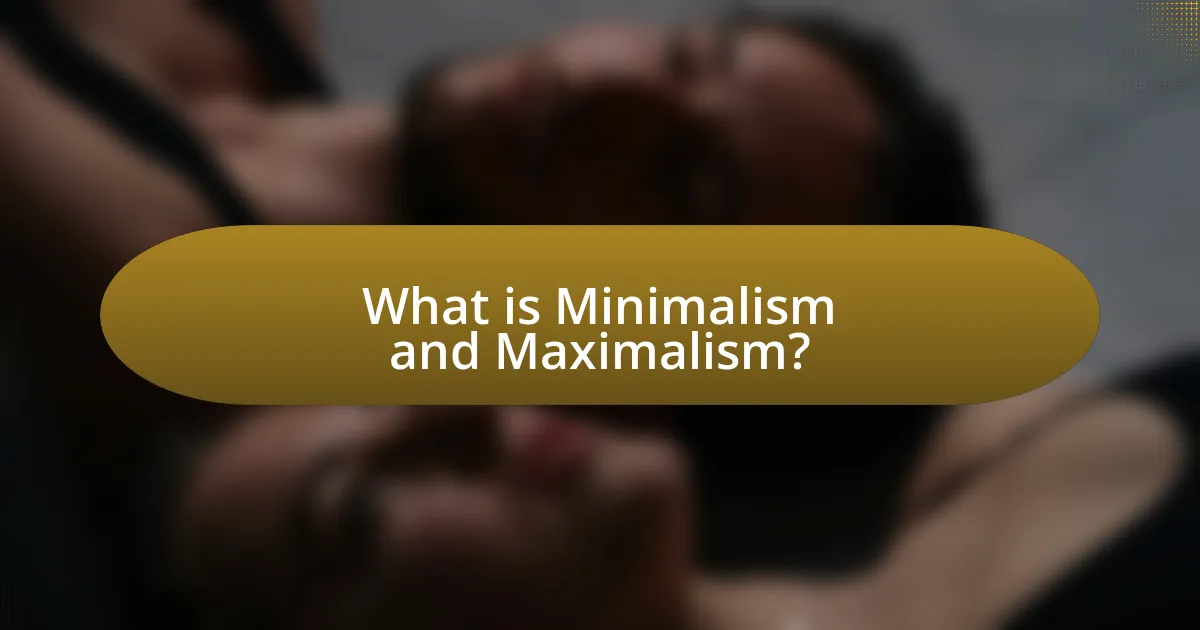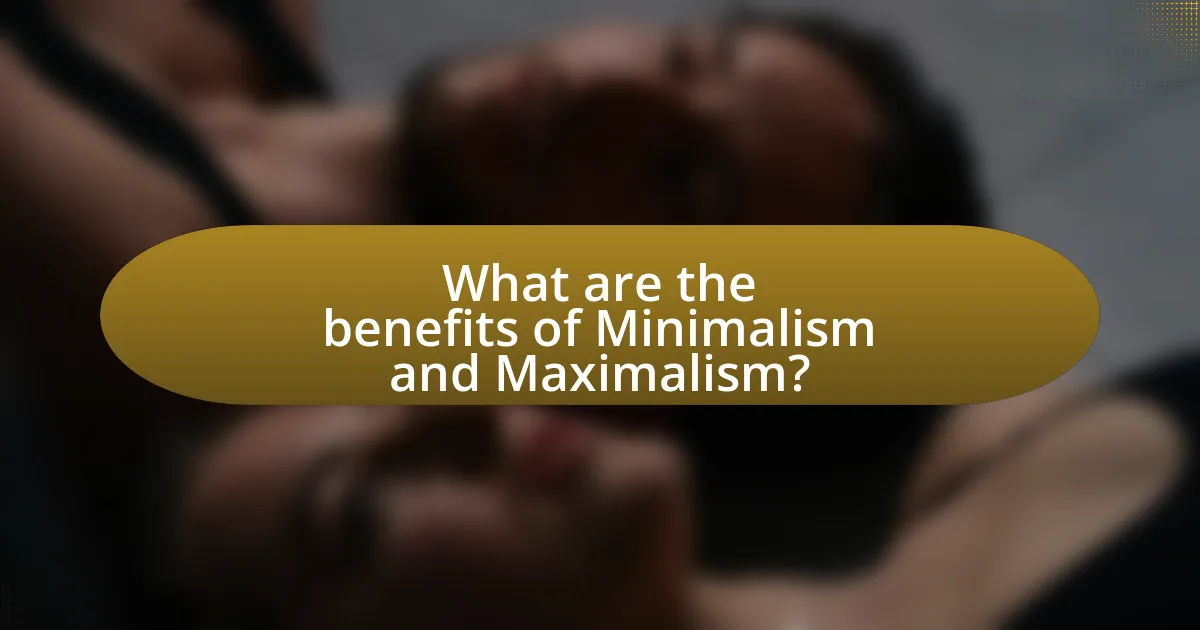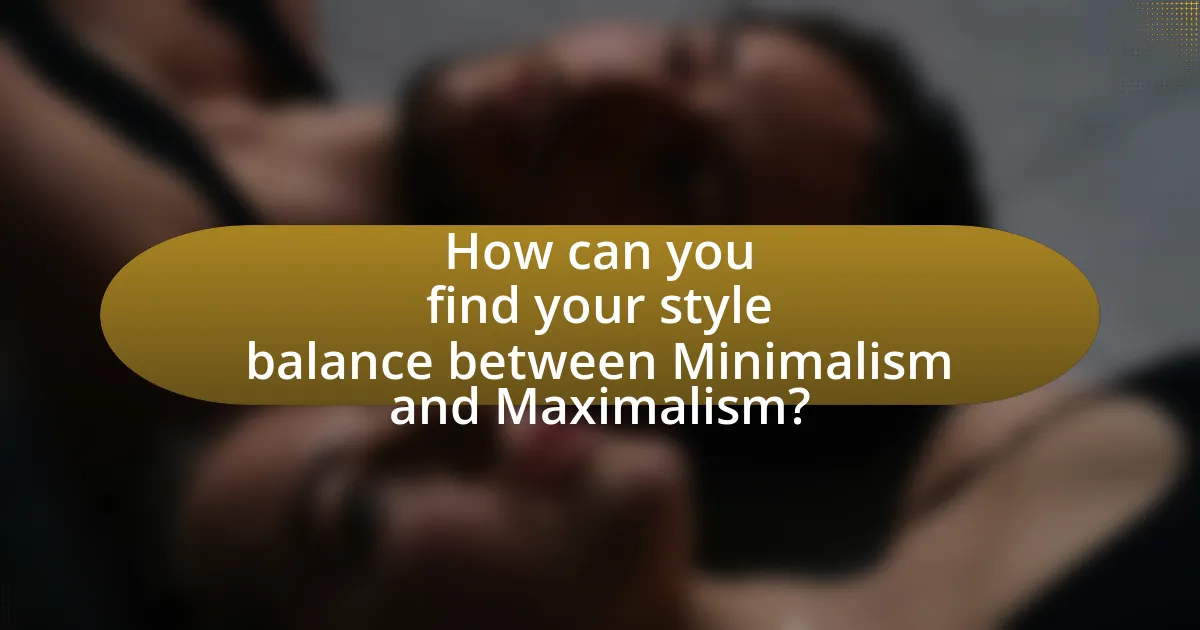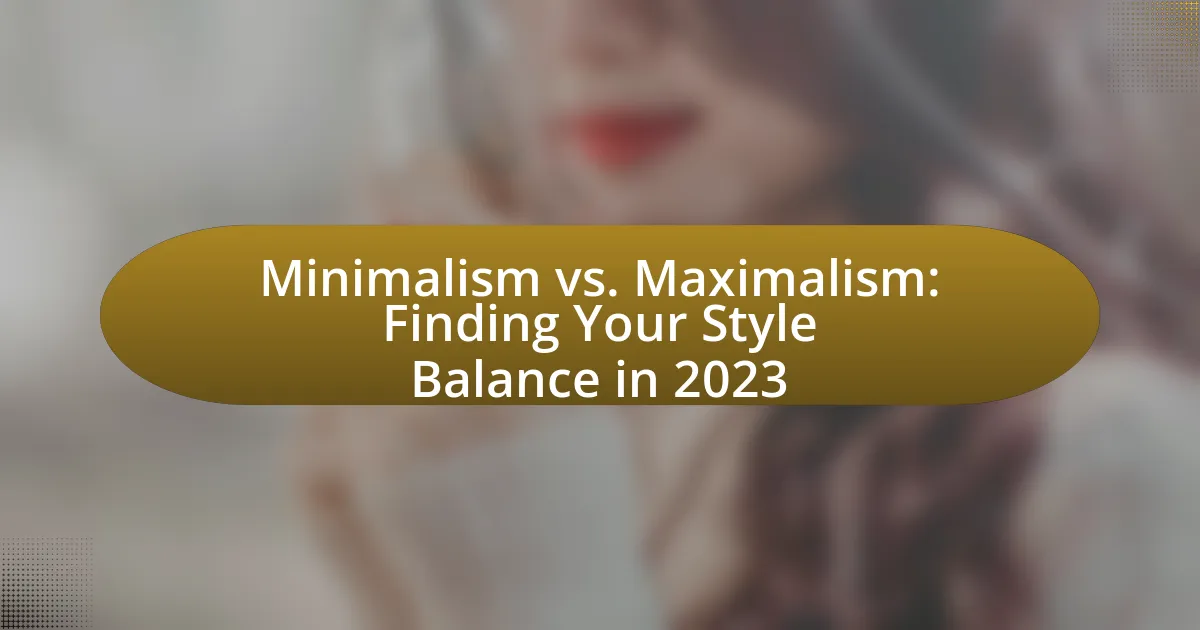The article explores the contrasting design philosophies of Minimalism and Maximalism, highlighting their core principles and relevance in 2023. Minimalism emphasizes simplicity, functionality, and intentionality, promoting reduced clutter and enhanced mental well-being, while Maximalism celebrates abundance, personalization, and eclecticism, fostering creativity and self-expression. The discussion includes how societal trends and technology influence these styles, the psychological and emotional benefits of each approach, and practical tips for achieving a balanced aesthetic in personal spaces. Ultimately, the article guides readers in assessing their preferences and lifestyle needs to find a harmonious blend of both styles.

What is Minimalism and Maximalism?
Minimalism is a design and lifestyle philosophy that emphasizes simplicity, functionality, and the reduction of excess, focusing on essential elements. In contrast, maximalism embraces abundance, boldness, and the layering of diverse styles, colors, and textures to create a rich, expressive environment. The distinction between these two approaches is evident in various fields, including art, architecture, and interior design, where minimalism often features clean lines and open spaces, while maximalism showcases intricate patterns and a mix of influences.
How do Minimalism and Maximalism differ in design philosophy?
Minimalism and Maximalism differ fundamentally in their design philosophies, with Minimalism emphasizing simplicity and functionality, while Maximalism embraces complexity and abundance. Minimalism prioritizes clean lines, open spaces, and a limited color palette to create a sense of calm and order, often reflecting the principle that “less is more.” In contrast, Maximalism celebrates eclecticism, layering, and vibrant colors, encouraging personal expression through a mix of patterns, textures, and decorative elements. This distinction is evident in various design applications, where Minimalist spaces often evoke tranquility, while Maximalist environments stimulate energy and creativity.
What are the core principles of Minimalism?
The core principles of Minimalism include simplicity, functionality, and intentionality. Simplicity emphasizes reducing clutter and distractions, allowing individuals to focus on what truly matters. Functionality prioritizes the usefulness of items, ensuring that each possession serves a purpose. Intentionality involves making conscious choices about what to keep and what to let go, fostering a lifestyle that aligns with personal values and goals. These principles are supported by the idea that a minimalist approach can lead to increased clarity, reduced stress, and enhanced well-being, as evidenced by various studies linking minimalism to improved mental health outcomes.
What are the core principles of Maximalism?
The core principles of Maximalism emphasize abundance, personalization, and eclecticism. Maximalism encourages the use of bold colors, diverse patterns, and a mix of textures to create visually rich environments. This approach values individual expression and the layering of various elements, allowing for a unique and personalized aesthetic. Historical context shows that Maximalism emerged as a reaction against Minimalism, promoting the idea that more is often more, and celebrating complexity in design and art.
Why are Minimalism and Maximalism relevant in 2023?
Minimalism and Maximalism are relevant in 2023 due to the ongoing cultural shift towards personal expression and sustainability. As individuals seek to define their identities in a complex world, Minimalism offers a way to simplify and declutter, promoting mental clarity and environmental consciousness. Conversely, Maximalism embraces boldness and individuality, allowing for creative expression through vibrant aesthetics and diverse influences. This duality reflects current societal trends where consumers are increasingly valuing authenticity and personal narratives in their choices, as evidenced by a 2022 survey indicating that 70% of consumers prefer brands that align with their personal values.
How have societal trends influenced these styles?
Societal trends have significantly influenced minimalism and maximalism by reflecting changing values and lifestyles. For instance, the rise of environmental awareness has propelled minimalism, as individuals seek to reduce waste and consumption, aligning with sustainable living practices. Conversely, maximalism has gained traction in response to a desire for personalization and self-expression, particularly in a digital age where individuality is celebrated. The COVID-19 pandemic further accelerated these trends; minimalism became appealing for its simplicity and tranquility, while maximalism offered a vibrant escape from the monotony of lockdowns. These shifts illustrate how societal values directly shape aesthetic preferences and lifestyle choices.
What role does technology play in shaping these aesthetics?
Technology significantly influences the aesthetics of minimalism and maximalism by providing tools that enhance design capabilities and accessibility. For minimalism, technology enables the creation of clean, efficient designs through software that allows for precise control over space and elements, exemplified by programs like Adobe Illustrator and Sketch. In contrast, maximalism benefits from technology by facilitating the integration of diverse materials and patterns, as seen in 3D printing and digital rendering, which allow designers to experiment with complex visuals. The rise of social media platforms, such as Instagram and Pinterest, further shapes these aesthetics by promoting trends and enabling instant sharing, thus influencing public perception and preferences in design.

What are the benefits of Minimalism and Maximalism?
Minimalism offers benefits such as reduced stress and increased focus by promoting simplicity and intentionality in possessions and lifestyle choices. Studies indicate that a minimalist approach can lead to improved mental well-being, as individuals often experience less clutter and distraction, allowing for greater clarity and productivity.
Conversely, maximalism provides benefits like self-expression and creativity through the embrace of abundance and diverse aesthetics. This style allows individuals to showcase their personality and interests, fostering a sense of identity and emotional connection to their environment. Research shows that environments rich in personal artifacts can enhance feelings of comfort and belonging, contributing positively to mental health.
Both styles cater to different needs and preferences, allowing individuals to choose a lifestyle that aligns with their values and enhances their quality of life.
How can Minimalism enhance your lifestyle?
Minimalism can enhance your lifestyle by promoting clarity and focus through the reduction of physical and mental clutter. By simplifying your environment and prioritizing essential items, you can experience reduced stress and increased productivity. Research indicates that individuals who adopt minimalist practices report higher levels of satisfaction and well-being, as they are less distracted by unnecessary possessions and commitments. For instance, a study published in the Journal of Environmental Psychology found that decluttering can lead to improved mental health outcomes, demonstrating the tangible benefits of a minimalist approach.
What psychological benefits does Minimalism offer?
Minimalism offers several psychological benefits, including reduced stress and increased focus. By eliminating excess possessions and distractions, individuals often experience a clearer mental state, which can lead to improved emotional well-being. Research indicates that a minimalist lifestyle can enhance mindfulness, as it encourages individuals to prioritize meaningful experiences over material accumulation. A study published in the Journal of Environmental Psychology found that individuals who embraced minimalism reported higher levels of life satisfaction and lower levels of anxiety, demonstrating the positive impact of simplicity on mental health.
How does Minimalism contribute to sustainability?
Minimalism contributes to sustainability by promoting reduced consumption and waste, which directly lowers environmental impact. By encouraging individuals to own fewer possessions, minimalism leads to less demand for production, thereby conserving resources and reducing pollution. For instance, a study published in the Journal of Cleaner Production found that minimalistic lifestyles can significantly decrease carbon footprints by minimizing the need for manufacturing and transportation of goods. This reduction in consumption aligns with sustainable practices, as it fosters a more mindful approach to resource use and encourages recycling and repurposing of existing items.
What advantages does Maximalism provide?
Maximalism provides a rich and vibrant aesthetic that encourages self-expression and creativity. This style allows individuals to showcase their personality through bold colors, diverse patterns, and an eclectic mix of decor, which can create a stimulating and dynamic environment. Research indicates that environments designed with maximalist principles can enhance mood and inspire creativity, as they often reflect personal stories and experiences, fostering a sense of belonging and identity.
How can Maximalism foster creativity and self-expression?
Maximalism fosters creativity and self-expression by encouraging individuals to embrace abundance and diversity in their artistic choices. This approach allows for the integration of various styles, colors, and textures, which can lead to unique and personalized creations. Research indicates that environments rich in stimuli, characteristic of maximalist aesthetics, can enhance creative thinking and problem-solving abilities. For instance, a study published in the Journal of Environmental Psychology found that individuals exposed to complex visual environments demonstrated higher levels of creative output compared to those in minimalist settings. Thus, maximalism not only provides a platform for self-expression but also actively stimulates the creative process.
What emotional benefits can be derived from a Maximalist approach?
A Maximalist approach can provide emotional benefits such as enhanced self-expression and increased joy. This style allows individuals to showcase their personality through diverse colors, patterns, and textures, fostering a sense of identity and belonging. Research indicates that environments rich in visual stimuli can stimulate positive emotions and creativity, contributing to overall well-being. For instance, a study published in the Journal of Environmental Psychology found that vibrant and eclectic spaces can elevate mood and inspire creativity, reinforcing the emotional advantages of embracing a Maximalist aesthetic.

How can you find your style balance between Minimalism and Maximalism?
To find your style balance between Minimalism and Maximalism, assess your personal preferences and lifestyle needs. Begin by identifying key elements from both styles that resonate with you; for instance, select a few essential minimalist pieces that provide functionality and clarity, while also incorporating maximalist accents that express your personality, such as bold colors or intricate patterns. Research indicates that a balanced approach can enhance both aesthetic appeal and emotional well-being, as seen in studies showing that environments reflecting personal identity contribute to greater satisfaction. By consciously curating your space with a mix of simplicity and vibrancy, you can achieve a harmonious balance that reflects your unique style.
What factors should you consider when choosing between Minimalism and Maximalism?
When choosing between Minimalism and Maximalism, consider personal values, lifestyle needs, and aesthetic preferences. Personal values dictate whether simplicity or abundance resonates more with an individual; for instance, Minimalism often aligns with a desire for clarity and focus, while Maximalism may reflect a love for diversity and expression. Lifestyle needs play a crucial role, as Minimalism can facilitate easier maintenance and organization, whereas Maximalism may cater to those who thrive in vibrant, eclectic environments. Aesthetic preferences also significantly influence the choice, with Minimalism emphasizing clean lines and open spaces, while Maximalism celebrates bold colors and intricate patterns. These factors collectively guide individuals in selecting a style that best fits their identity and living situation.
How does your personal lifestyle influence your style choice?
Personal lifestyle significantly influences style choice by dictating preferences for simplicity or complexity in clothing and decor. For instance, individuals who prioritize minimalism often choose streamlined, functional pieces that reflect their values of efficiency and clarity, while those with a maximalist lifestyle may opt for bold patterns and eclectic combinations that express their creativity and individuality. Research indicates that lifestyle factors such as daily routines, social activities, and personal values directly shape these aesthetic preferences, reinforcing the connection between how one lives and what one wears or surrounds themselves with.
What role does space play in determining your style balance?
Space plays a crucial role in determining style balance by influencing how elements are perceived and interact within a design. In minimalism, ample negative space enhances simplicity and clarity, allowing each element to stand out, while in maximalism, the use of space can create a sense of abundance and richness, where elements are layered and clustered to evoke a dynamic visual experience. Research indicates that effective use of space can significantly impact aesthetic appeal and functionality, as demonstrated in studies on design psychology, which show that well-balanced spaces can enhance user satisfaction and engagement.
What practical tips can help you achieve a balanced style?
To achieve a balanced style, focus on combining elements of minimalism and maximalism thoughtfully. Start by selecting a neutral color palette as a base, which allows for versatility and cohesion in your outfits. Incorporate statement pieces, such as bold accessories or unique patterns, to add personality without overwhelming the overall look. Additionally, maintain a balance in proportions by pairing fitted items with looser pieces, ensuring that no single element dominates the outfit. This approach is supported by fashion experts who emphasize the importance of harmony in style, suggesting that a well-curated mix of simplicity and flair can enhance personal expression while maintaining visual appeal.
How can you incorporate elements of both styles in your home?
To incorporate elements of both minimalism and maximalism in your home, select a few statement pieces that reflect maximalist aesthetics, such as bold artwork or vibrant textiles, while maintaining a clean and uncluttered backdrop typical of minimalism. This approach allows for a harmonious blend where the simplicity of minimalism highlights the complexity of maximalist elements, creating a balanced visual experience. For instance, a minimalist room can feature a single large, colorful painting on a neutral wall, ensuring that the artwork stands out without overwhelming the space.
What are some common mistakes to avoid when blending Minimalism and Maximalism?
Common mistakes to avoid when blending Minimalism and Maximalism include overloading spaces with too many contrasting elements, which can create visual chaos. This occurs when individuals fail to establish a cohesive color palette or theme, leading to disjointed aesthetics. Additionally, neglecting functionality in favor of decorative items can result in clutter, undermining the minimalist principle of simplicity. Lastly, not considering scale and proportion can lead to an imbalance, where oversized maximalist pieces overwhelm minimalist elements, disrupting harmony in the overall design.

Leave a Reply